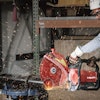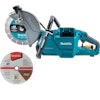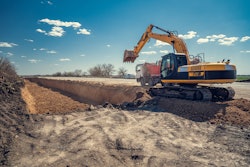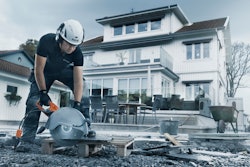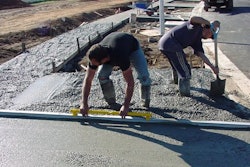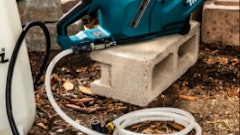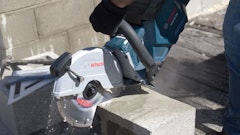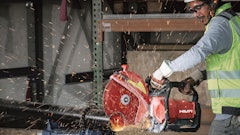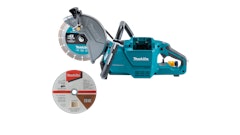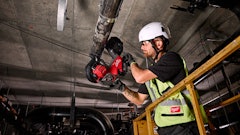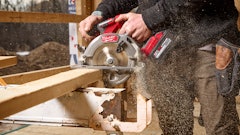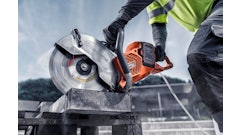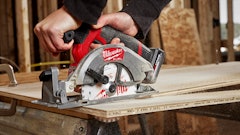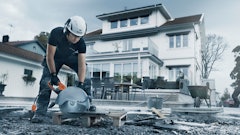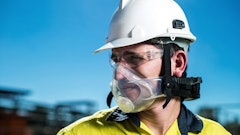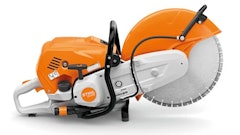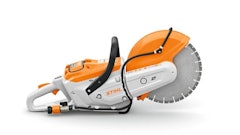
As Brian Hendrickson, trade manager for rental and retail, Hilti, reflects on recent trends in the concrete cutting equipment industry, battery technology stands out to him the most.
After all, battery technology is associated with more advancements in concrete cutting than anything else, as the ability to conduct applications—which previously required gasoline-powered equipment—with batteries is “a huge change in the industry,” according to Hendrickson.
Due to battery-powered concrete cutting equipment, rental store owners and end users alike have simplified the rental process overall. For instance, Hendrickson believes that battery concrete saws’ check-in/check-out processes are very straightforward. Rental store owners simply need to place a battery on each of their saws and pull the trigger. If the saw starts, it’s fully ready for the next rental, as owners don’t have to maintain any filters, spark plugs or starter ropes.
“(Some) batteries also have the ability to self-diagnose, so they’re always ready for the next rental,” Hendrickson says. “End users never have to worry about the correct gas and oil mixture or the risk of flooding.”
Additionally, by using certain batteries for their concrete saws, end users won’t have to be concerned about temperature changes because they never influence the saws’ starting capabilities. Noise decreases considerably too, while harmful emissions are never released, enabling end users to utilize them in tight, enclosed spaces.
Future battery-powered offerings
As a result of their various positives, Mark Michaels, senior director of product management, Husqvarna Construction North America, believes more concrete cutting equipment will be powered by batteries in the near future. In fact, due to continuous technological advancements, which are improving run times and functionalities, battery-powered products that are currently considered “niche” will become mainstream in the coming years.
The primary reasons? According to Michaels, batteries can be used for a variety of applications within several different types of work environments. Not to mention, they’ll also continue to perform if users’ jobsites encounter electrical issues, such as generators that aren’t operating properly.
“Products powered by batteries will remain stable, leading to reduced maintenance costs for rental stores,” Michaels says. “And, because they are easier to start, end users will experience consistent performance.”
As an example of battery-powered equipment expansions, John Allen, product manager, Stihl, stresses that the manufacturer will be releasing more battery-powered cut-off machine offerings next year. In addition, it will unveil larger units with more power, continued fuel injection technology, wheel design advancements and smart connector capabilities.
“Through innovative solutions, operators can easily view transparent data about their tool’s run time, usage, maintenance schedule, last known location and more,” Allen says. “This technology makes it easier for shop owners to manage and track their tools as they are being loaned out. At the same time, we’ll continue to engineer with end users’ needs in mind, too.”
Meanwhile, some manufacturers like Edco have added telematics to their cutting equipment, according to Ed Chrisinger, Southeast regional sales manager, Edco. Consequently, rental stores can utilize GPS to track it, which is especially critical if it’s on a jobsite they need to locate prior to pick up. And, of equal importance, the saw’s telematics enable rental stores to acquire accurate operating hours of usage, thereby ensuring there aren’t any disputes about how long it was operated for.
Moreover, rental stores can use telematics to create a maintenance service schedule, based on each saw’s hours of usage. As a result, the saws will always be serviced on proper schedules, ensuring that major downtime and lost rental opportunities are prevented.
“On each saw, the manufacturer uses QRC codes, which show end users how to correctly operate their equipment, as they can watch a training video upon scanning a QRC code on their phone,” Chrisinger explains. “The video discusses how they can operate their saw, install its diamond blade and properly cut. By acquiring step-cutting techniques, end users won’t drop their saw’s blade all the way down and cut too much too fast and can avoid equipment damage.”
Aside from benefiting end users, QRC codes will help rental stores too, as they’ll receive access to part breakdowns and operation manuals concerning their particular equipment. Therefore, if a rental store’s mechanics have to order a part immediately, they can access part breakdowns by scanning the QRC code on their phone prior to finding whichever part they need and ordering it, resulting in time savings.
Continuous education
To educate customers, particularly DIY users, on the ways in which they can use their concrete cutting equipment, rental centers should consider the following two methods, according to Michaels.
First, they should offer their employees continuous education on manufacturers' products.
Furthermore, questions are essential, as rental center employees should be focused on enhancing their customers’ safety and efficiency, particularly by simplifying their equipment’s usability. To do so, they must ensure their customers will fit their preferred applications with whichever machines and diamond tools are the most appropriate—each of which can be verified through proper questioning.
“Rental center employees should ask enough questions to determine the type of material that needs to be cut, the size of the job and the relative experience of the operator, whether they’re a DIY user or an expert,” Michaels says.
Chrisinger agrees, adding that rental center employees should ask their customers the following questions.
- How deep do you need to cut?
- What are you cutting through?
- What kind of power do you need for this job?
- How long of a cut do you need to make?
“By receiving answers to these questions, rental stores will provide their customers the saws and diamond blades they need for their specific jobs, leading to successful rental experiences, time after time,” Chrisinger says.



